Finite Element Analysis Problems with Solution 2022
VerifiedAdded on 2022/09/15
|7
|1525
|25
AI Summary
Contribute Materials
Your contribution can guide someone’s learning journey. Share your
documents today.
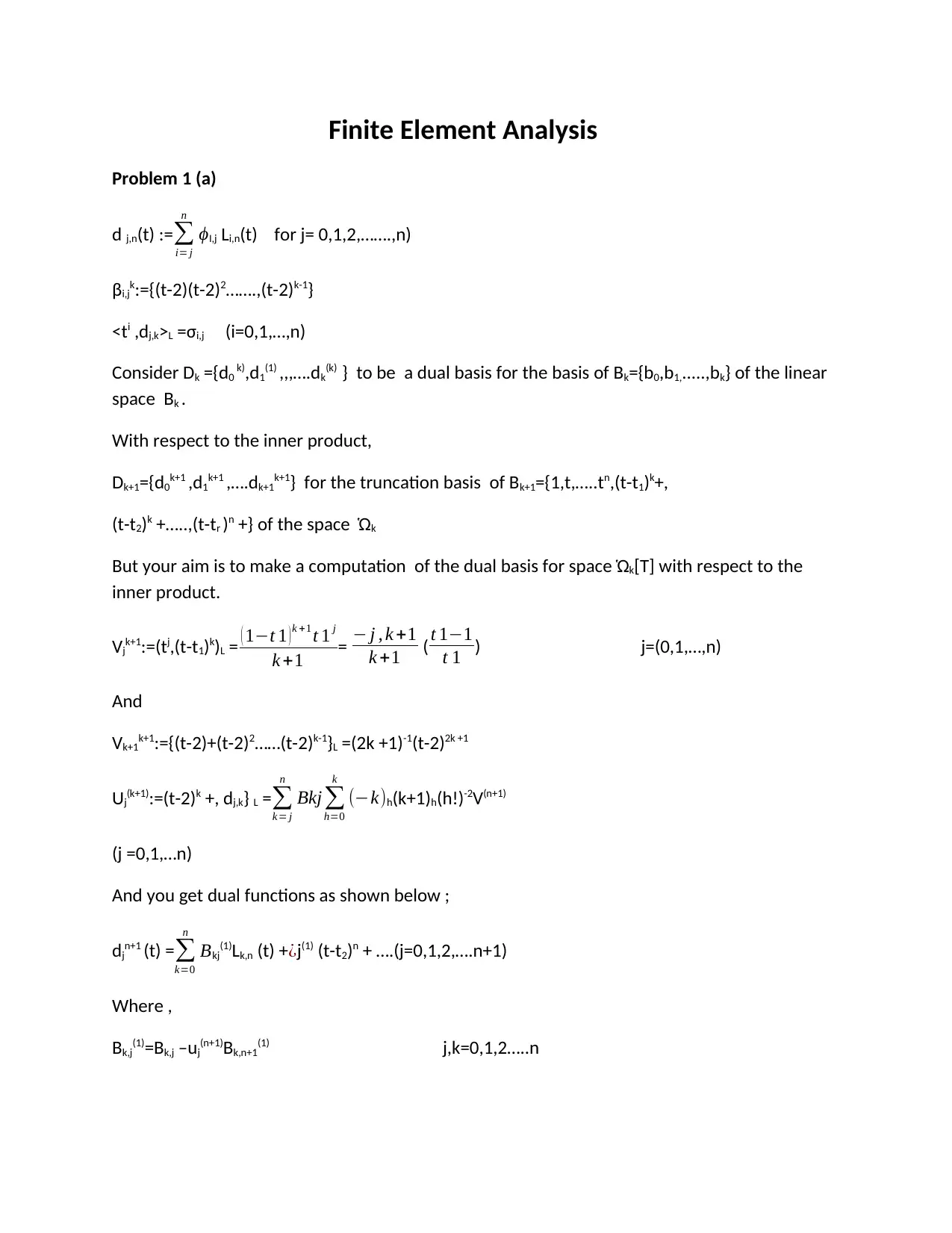
Finite Element Analysis
Problem 1 (a)
d j,n(t) :=∑
i= j
n
ϕI,j Li,n(t) for j= 0,1,2,…….,n)
βi,jk:={(t-2)(t-2)2…….,(t-2)k-1}
<ti ,dj,k>L =σi,j (i=0,1,…,n)
Consider Dk ={d0 k),d1(1) ,,,….dk(k) } to be a dual basis for the basis of Bk={b0,b1,.....,bk} of the linear
space Bk .
With respect to the inner product,
Dk+1={d0k+1 ,d1k+1 ,….dk+1k+1} for the truncation basis of Bk+1={1,t,…..tn,(t-t1)k+,
(t-t2)k +…..,(t-tr )n +} of the space Ὡk
But your aim is to make a computation of the dual basis for space Ὡk[T] with respect to the
inner product.
Vjk+1:=(tj,(t-t1)k)L = ( 1−t 1 ) k +1 t 1 j
k +1 = − j , k +1
k +1 ( t 1−1
t 1 ) j=(0,1,…,n)
And
Vk+1k+1:={(t-2)+(t-2)2……(t-2)k-1}L =(2k +1)-1(t-2)2k +1
Uj(k+1):=(t-2)k +, dj,k} L =∑
k= j
n
Bkj ∑
h=0
k
(−k)h(k+1)h(h!)-2V(n+1)
(j =0,1,…n)
And you get dual functions as shown below ;
djn+1 (t) =∑
k=0
n
Bkj(1)Lk,n (t) +¿j(1) (t-t2)n + ….(j=0,1,2,….n+1)
Where ,
Βk,j(1)=Bk,j –uj(n+1)Bk,n+1(1) j,k=0,1,2…..n
Problem 1 (a)
d j,n(t) :=∑
i= j
n
ϕI,j Li,n(t) for j= 0,1,2,…….,n)
βi,jk:={(t-2)(t-2)2…….,(t-2)k-1}
<ti ,dj,k>L =σi,j (i=0,1,…,n)
Consider Dk ={d0 k),d1(1) ,,,….dk(k) } to be a dual basis for the basis of Bk={b0,b1,.....,bk} of the linear
space Bk .
With respect to the inner product,
Dk+1={d0k+1 ,d1k+1 ,….dk+1k+1} for the truncation basis of Bk+1={1,t,…..tn,(t-t1)k+,
(t-t2)k +…..,(t-tr )n +} of the space Ὡk
But your aim is to make a computation of the dual basis for space Ὡk[T] with respect to the
inner product.
Vjk+1:=(tj,(t-t1)k)L = ( 1−t 1 ) k +1 t 1 j
k +1 = − j , k +1
k +1 ( t 1−1
t 1 ) j=(0,1,…,n)
And
Vk+1k+1:={(t-2)+(t-2)2……(t-2)k-1}L =(2k +1)-1(t-2)2k +1
Uj(k+1):=(t-2)k +, dj,k} L =∑
k= j
n
Bkj ∑
h=0
k
(−k)h(k+1)h(h!)-2V(n+1)
(j =0,1,…n)
And you get dual functions as shown below ;
djn+1 (t) =∑
k=0
n
Bkj(1)Lk,n (t) +¿j(1) (t-t2)n + ….(j=0,1,2,….n+1)
Where ,
Βk,j(1)=Bk,j –uj(n+1)Bk,n+1(1) j,k=0,1,2…..n
Secure Best Marks with AI Grader
Need help grading? Try our AI Grader for instant feedback on your assignments.
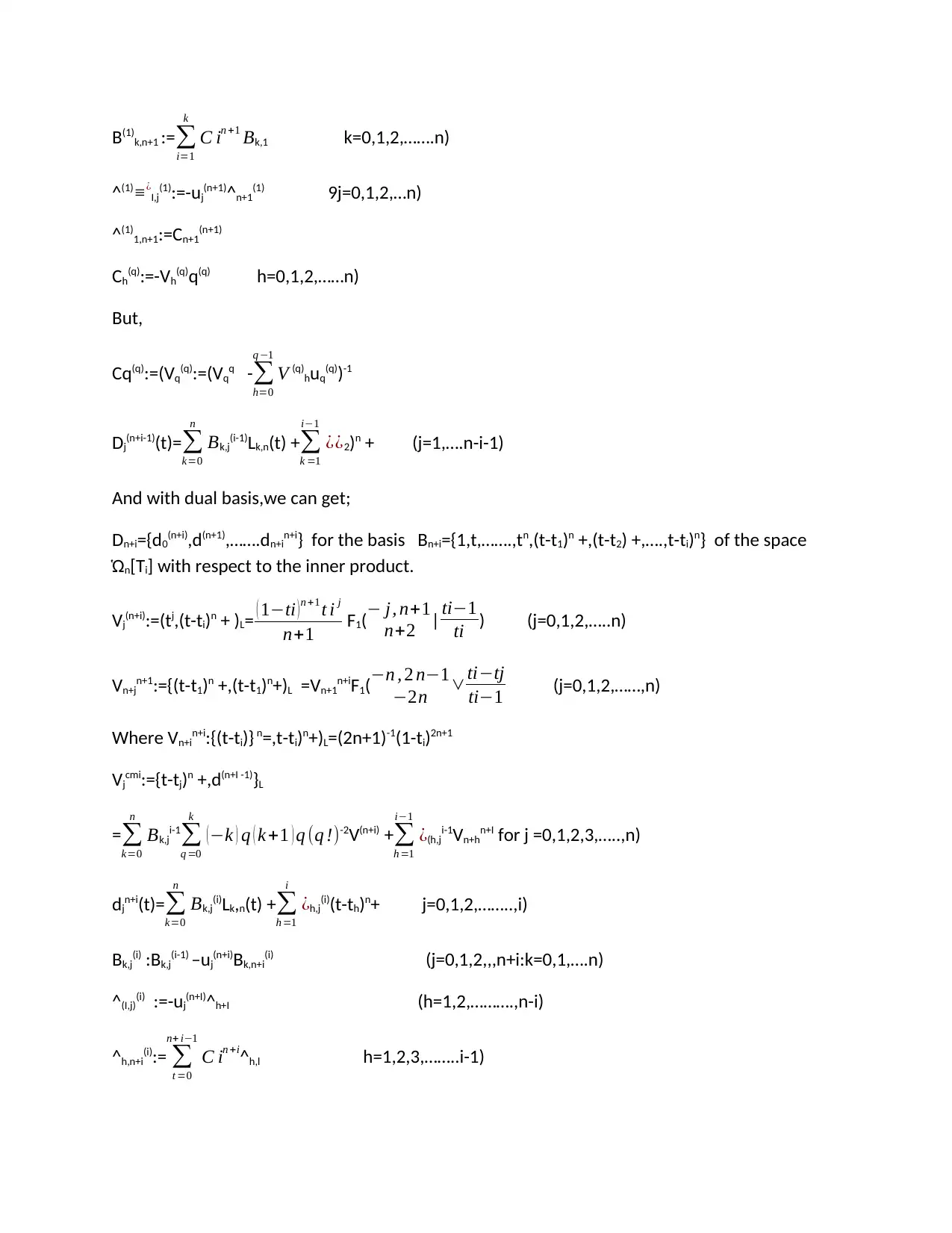
B(1)k,n+1 :=∑
i=1
k
C in +1 Bk,1 k=0,1,2,…….n)
^(1)
≡¿
I,j(1):=-uj(n+1)^n+1(1) 9j=0,1,2,…n)
^(1)1,n+1:=Cn+1(n+1)
Ch(q):=-Vh(q)q(q) h=0,1,2,……n)
But,
Cq(q):=(Vq(q):=(Vqq -∑
h=0
q −1
V (q)huq(q))-1
Dj(n+i-1)(t)=∑
k=0
n
Bk,j(i-1)Lk,n(t) +∑
k =1
i−1
¿¿2)n + (j=1,….n-i-1)
And with dual basis,we can get;
Dn+i={d0(n+i),d(n+1),…….dn+in+i} for the basis Bn+i={1,t,…….,tn,(t-t1)n +,(t-t2) +,….,t-ti)n} of the space
Ὡn[Ti] with respect to the inner product.
Vj(n+i):=(tj,(t-ti)n + )L= ( 1−ti ) n +1 t i j
n+1 F1(
− j, n+1
n+2 | ti−1
ti ) (j=0,1,2,…..n)
Vn+jn+1:={(t-t1)n +,(t-t1)n+)L =Vn+1n+iF1(−n , 2 n−1
−2n ∨ti−tj
ti−1 (j=0,1,2,……,n)
Where Vn+in+i:{(t-ti)} n=,t-ti)n+)L=(2n+1)-1(1-ti)2n+1
Vjcmi:={t-tj)n +,d(n+I -1)}L
=∑
k=0
n
Bk,ji-1
∑
q =0
k
( −k ) q ( k +1 ) q (q !)-2V(n+i) +∑
h =1
i−1
¿(h,ji-1Vn+hn+I for j =0,1,2,3,…..,n)
djn+i(t)= ∑
k=0
n
Bk,j(i)Lk,n(t) +∑
h =1
i
¿h,j(i)(t-th)n+ j=0,1,2,……..,i)
Bk,j(i) :Bk,j(i-1) –uj(n+i)Bk,n+i(i) (j=0,1,2,,,n+i:k=0,1,….n)
^(I,j)(i) :=-uj(n+I)^h+I (h=1,2,……….,n-i)
^h,n+i(i):= ∑
t =0
n+ i−1
C in +i^h,l h=1,2,3,……..i-1)
i=1
k
C in +1 Bk,1 k=0,1,2,…….n)
^(1)
≡¿
I,j(1):=-uj(n+1)^n+1(1) 9j=0,1,2,…n)
^(1)1,n+1:=Cn+1(n+1)
Ch(q):=-Vh(q)q(q) h=0,1,2,……n)
But,
Cq(q):=(Vq(q):=(Vqq -∑
h=0
q −1
V (q)huq(q))-1
Dj(n+i-1)(t)=∑
k=0
n
Bk,j(i-1)Lk,n(t) +∑
k =1
i−1
¿¿2)n + (j=1,….n-i-1)
And with dual basis,we can get;
Dn+i={d0(n+i),d(n+1),…….dn+in+i} for the basis Bn+i={1,t,…….,tn,(t-t1)n +,(t-t2) +,….,t-ti)n} of the space
Ὡn[Ti] with respect to the inner product.
Vj(n+i):=(tj,(t-ti)n + )L= ( 1−ti ) n +1 t i j
n+1 F1(
− j, n+1
n+2 | ti−1
ti ) (j=0,1,2,…..n)
Vn+jn+1:={(t-t1)n +,(t-t1)n+)L =Vn+1n+iF1(−n , 2 n−1
−2n ∨ti−tj
ti−1 (j=0,1,2,……,n)
Where Vn+in+i:{(t-ti)} n=,t-ti)n+)L=(2n+1)-1(1-ti)2n+1
Vjcmi:={t-tj)n +,d(n+I -1)}L
=∑
k=0
n
Bk,ji-1
∑
q =0
k
( −k ) q ( k +1 ) q (q !)-2V(n+i) +∑
h =1
i−1
¿(h,ji-1Vn+hn+I for j =0,1,2,3,…..,n)
djn+i(t)= ∑
k=0
n
Bk,j(i)Lk,n(t) +∑
h =1
i
¿h,j(i)(t-th)n+ j=0,1,2,……..,i)
Bk,j(i) :Bk,j(i-1) –uj(n+i)Bk,n+i(i) (j=0,1,2,,,n+i:k=0,1,….n)
^(I,j)(i) :=-uj(n+I)^h+I (h=1,2,……….,n-i)
^h,n+i(i):= ∑
t =0
n+ i−1
C in +i^h,l h=1,2,3,……..i-1)
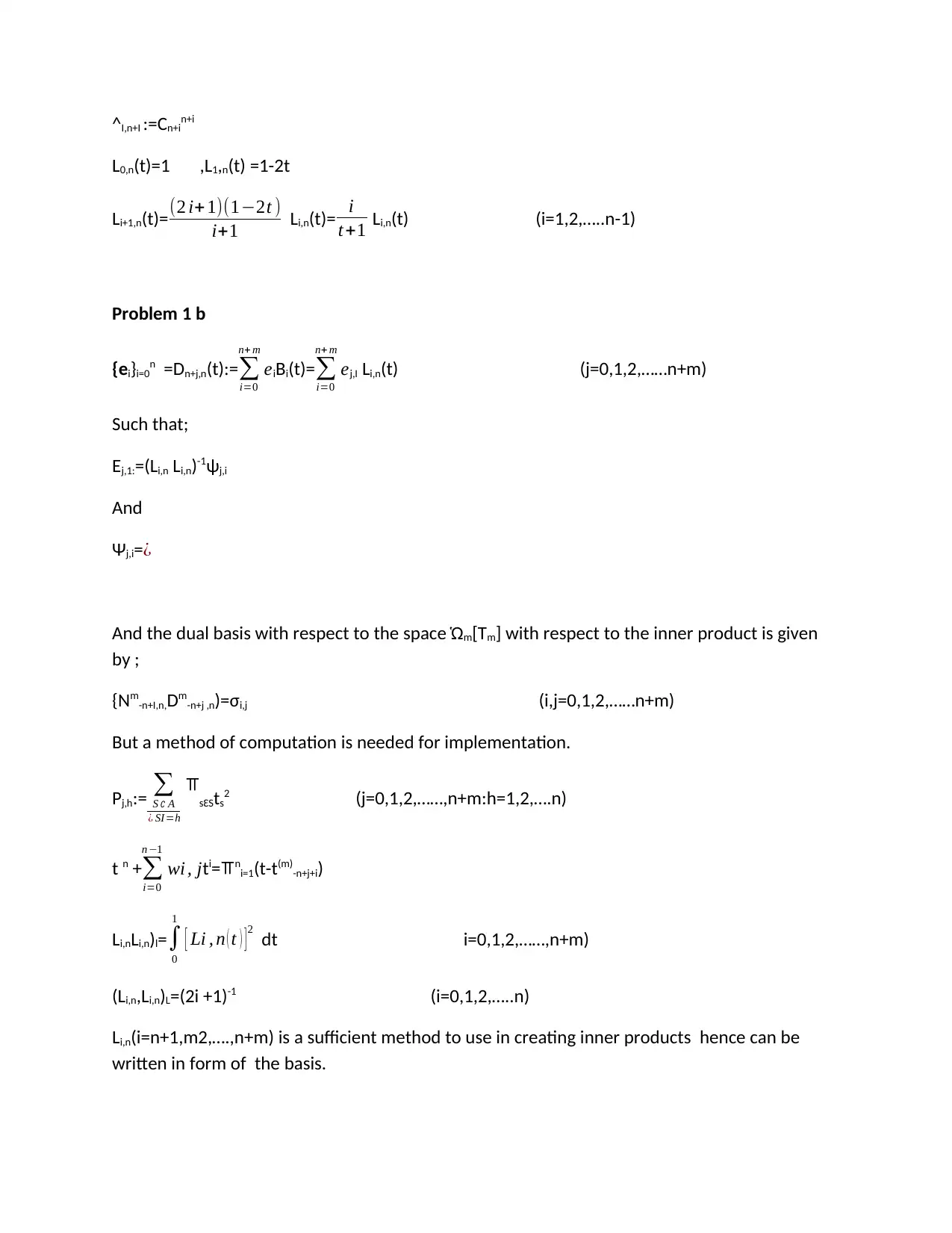
^I,n+I :=Cn+in+i
L0,n(t)=1 ,L1,n(t) =1-2t
Li+1,n(t)=(2 i+ 1)(1−2t )
i+1 Li,n(t)= i
t+1 Li,n(t) (i=1,2,…..n-1)
Problem 1 b
{ei}i=0n =Dn+j,n(t):= ∑
i=0
n+ m
eiBi(t)= ∑
i=0
n+ m
ej,I Li,n(t) (j=0,1,2,……n+m)
Such that;
Ej,1:=(Li,n Li,n)-1ѱj,i
And
Ѱj,i=¿
And the dual basis with respect to the space Ὡm[Tm] with respect to the inner product is given
by ;
{Nm-n+I,n,Dm-n+j ,n)=σi,j (i,j=0,1,2,……n+m)
But a method of computation is needed for implementation.
Pj,h:= ∑
S ∁ A
¿ SI=h
⫪sƐSts2 (j=0,1,2,……,n+m:h=1,2,….n)
t n +∑
i=0
n −1
wi , jti=⫪ni=1(t-t(m)-n+j+i)
Li,nLi,n)l=∫
0
1
[ Li , n ( t ) ] 2
dt i=0,1,2,……,n+m)
(Li,n,Li,n)L=(2i +1)-1 (i=0,1,2,…..n)
Li,n(i=n+1,m2,….,n+m) is a sufficient method to use in creating inner products hence can be
written in form of the basis.
L0,n(t)=1 ,L1,n(t) =1-2t
Li+1,n(t)=(2 i+ 1)(1−2t )
i+1 Li,n(t)= i
t+1 Li,n(t) (i=1,2,…..n-1)
Problem 1 b
{ei}i=0n =Dn+j,n(t):= ∑
i=0
n+ m
eiBi(t)= ∑
i=0
n+ m
ej,I Li,n(t) (j=0,1,2,……n+m)
Such that;
Ej,1:=(Li,n Li,n)-1ѱj,i
And
Ѱj,i=¿
And the dual basis with respect to the space Ὡm[Tm] with respect to the inner product is given
by ;
{Nm-n+I,n,Dm-n+j ,n)=σi,j (i,j=0,1,2,……n+m)
But a method of computation is needed for implementation.
Pj,h:= ∑
S ∁ A
¿ SI=h
⫪sƐSts2 (j=0,1,2,……,n+m:h=1,2,….n)
t n +∑
i=0
n −1
wi , jti=⫪ni=1(t-t(m)-n+j+i)
Li,nLi,n)l=∫
0
1
[ Li , n ( t ) ] 2
dt i=0,1,2,……,n+m)
(Li,n,Li,n)L=(2i +1)-1 (i=0,1,2,…..n)
Li,n(i=n+1,m2,….,n+m) is a sufficient method to use in creating inner products hence can be
written in form of the basis.
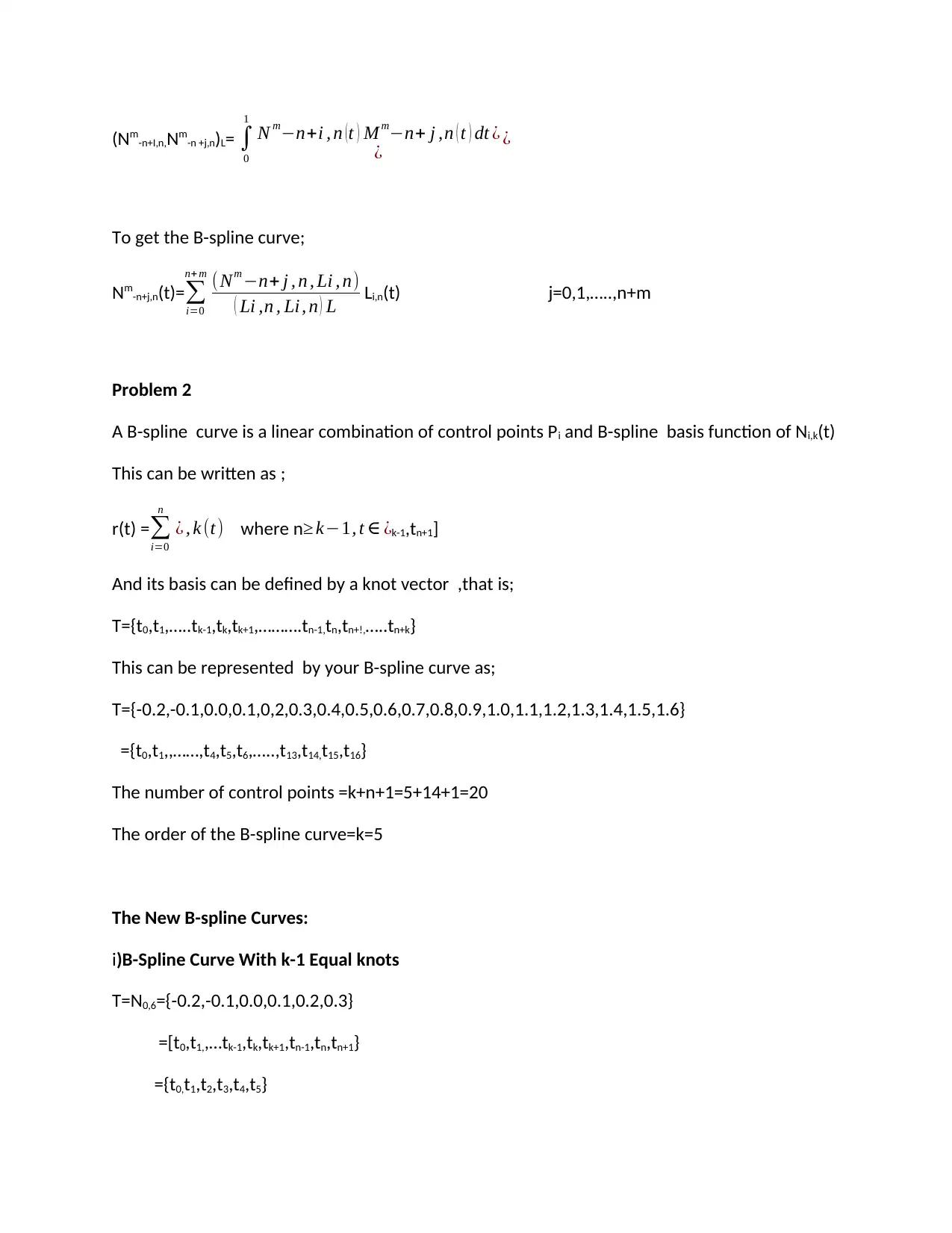
(Nm-n+I,n,Nm-n +j,n)L= ∫
0
1
N m−n+i , n ( t ) M m−n+ j ,n ( t ) dt ¿
¿ ¿
To get the B-spline curve;
Nm-n+j,n(t)= ∑
i=0
n+ m (Nm −n+ j , n , Li , n)
( Li ,n , Li , n ) L Li,n(t) j=0,1,…..,n+m
Problem 2
A B-spline curve is a linear combination of control points Pi and B-spline basis function of Ni,k(t)
This can be written as ;
r(t) =∑
i=0
n
¿ , k (t) where n≥ k−1, t ∈ ¿k-1,tn+1]
And its basis can be defined by a knot vector ,that is;
T={t0,t1,…..tk-1,tk,tk+1,……….tn-1,tn,tn+!,…..tn+k}
This can be represented by your B-spline curve as;
T={-0.2,-0.1,0.0,0.1,0,2,0.3,0.4,0.5,0.6,0.7,0.8,0.9,1.0,1.1,1.2,1.3,1.4,1.5,1.6}
={t0,t1,,……,t4,t5,t6,…..,t13,t14,t15,t16}
The number of control points =k+n+1=5+14+1=20
The order of the B-spline curve=k=5
The New B-spline Curves:
i)B-Spline Curve With k-1 Equal knots
T=N0,6={-0.2,-0.1,0.0,0.1,0.2,0.3}
=[t0,t1,,…tk-1,tk,tk+1,tn-1,tn,tn+1}
={t0,t1,t2,t3,t4,t5}
0
1
N m−n+i , n ( t ) M m−n+ j ,n ( t ) dt ¿
¿ ¿
To get the B-spline curve;
Nm-n+j,n(t)= ∑
i=0
n+ m (Nm −n+ j , n , Li , n)
( Li ,n , Li , n ) L Li,n(t) j=0,1,…..,n+m
Problem 2
A B-spline curve is a linear combination of control points Pi and B-spline basis function of Ni,k(t)
This can be written as ;
r(t) =∑
i=0
n
¿ , k (t) where n≥ k−1, t ∈ ¿k-1,tn+1]
And its basis can be defined by a knot vector ,that is;
T={t0,t1,…..tk-1,tk,tk+1,……….tn-1,tn,tn+!,…..tn+k}
This can be represented by your B-spline curve as;
T={-0.2,-0.1,0.0,0.1,0,2,0.3,0.4,0.5,0.6,0.7,0.8,0.9,1.0,1.1,1.2,1.3,1.4,1.5,1.6}
={t0,t1,,……,t4,t5,t6,…..,t13,t14,t15,t16}
The number of control points =k+n+1=5+14+1=20
The order of the B-spline curve=k=5
The New B-spline Curves:
i)B-Spline Curve With k-1 Equal knots
T=N0,6={-0.2,-0.1,0.0,0.1,0.2,0.3}
=[t0,t1,,…tk-1,tk,tk+1,tn-1,tn,tn+1}
={t0,t1,t2,t3,t4,t5}
Secure Best Marks with AI Grader
Need help grading? Try our AI Grader for instant feedback on your assignments.
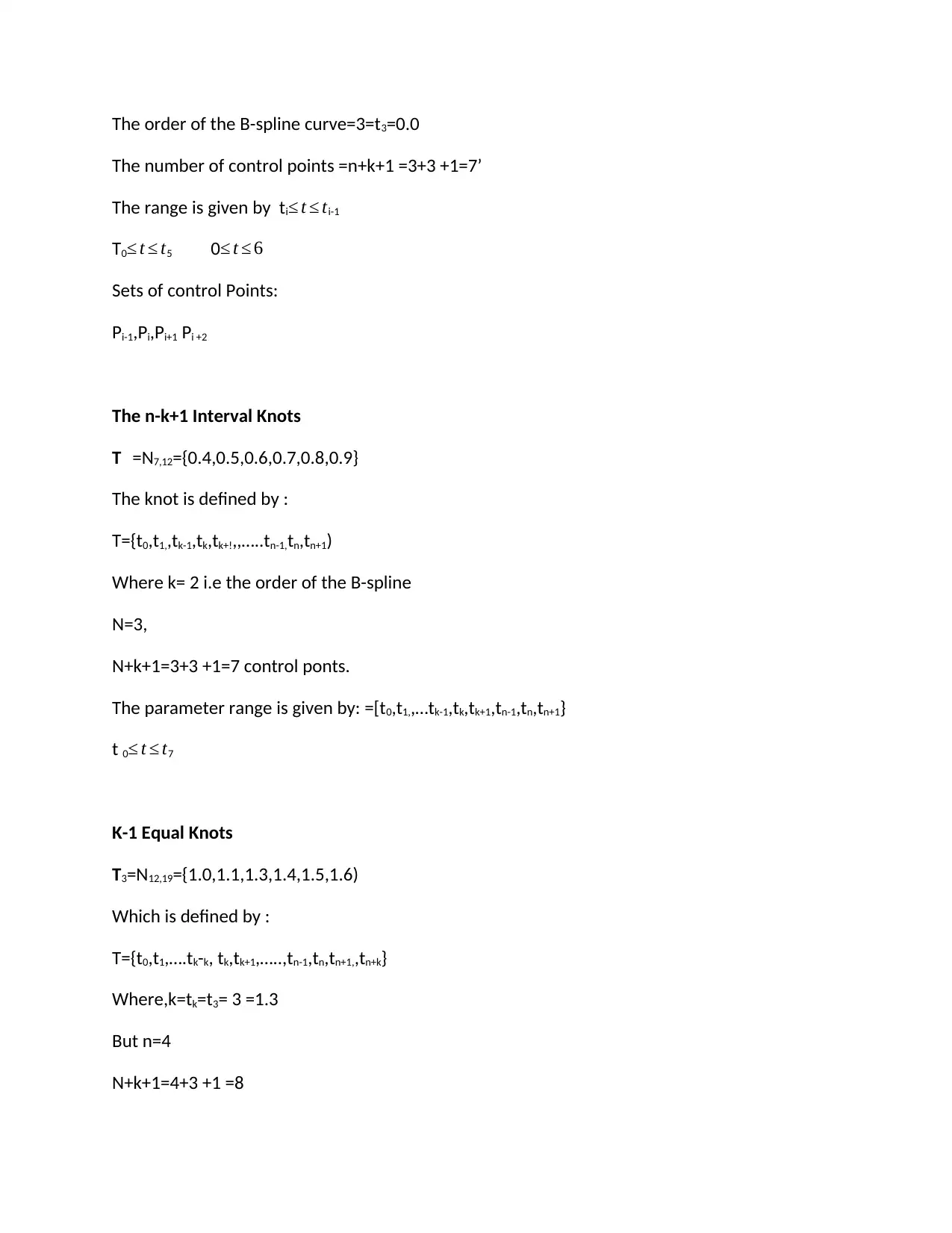
The order of the B-spline curve=3=t3=0.0
The number of control points =n+k+1 =3+3 +1=7’
The range is given by ti≤ t ≤ ti-1
T0≤ t ≤ t5 0≤ t ≤ 6
Sets of control Points:
Pi-1,Pi,Pi+1 Pi +2
The n-k+1 Interval Knots
T =N7,12={0.4,0.5,0.6,0.7,0.8,0.9}
The knot is defined by :
T={t0,t1,,tk-1,tk,tk+!,,…..tn-1,tn,tn+1)
Where k= 2 i.e the order of the B-spline
N=3,
N+k+1=3+3 +1=7 control ponts.
The parameter range is given by: =[t0,t1,,…tk-1,tk,tk+1,tn-1,tn,tn+1}
t 0≤ t ≤ t7
K-1 Equal Knots
T3=N12,19={1.0,1.1,1.3,1.4,1.5,1.6)
Which is defined by :
T={t0,t1,….tk-k, tk,tk+1,…..,tn-1,tn,tn+1,,tn+k}
Where,k=tk=t3= 3 =1.3
But n=4
N+k+1=4+3 +1 =8
The number of control points =n+k+1 =3+3 +1=7’
The range is given by ti≤ t ≤ ti-1
T0≤ t ≤ t5 0≤ t ≤ 6
Sets of control Points:
Pi-1,Pi,Pi+1 Pi +2
The n-k+1 Interval Knots
T =N7,12={0.4,0.5,0.6,0.7,0.8,0.9}
The knot is defined by :
T={t0,t1,,tk-1,tk,tk+!,,…..tn-1,tn,tn+1)
Where k= 2 i.e the order of the B-spline
N=3,
N+k+1=3+3 +1=7 control ponts.
The parameter range is given by: =[t0,t1,,…tk-1,tk,tk+1,tn-1,tn,tn+1}
t 0≤ t ≤ t7
K-1 Equal Knots
T3=N12,19={1.0,1.1,1.3,1.4,1.5,1.6)
Which is defined by :
T={t0,t1,….tk-k, tk,tk+1,…..,tn-1,tn,tn+1,,tn+k}
Where,k=tk=t3= 3 =1.3
But n=4
N+k+1=4+3 +1 =8
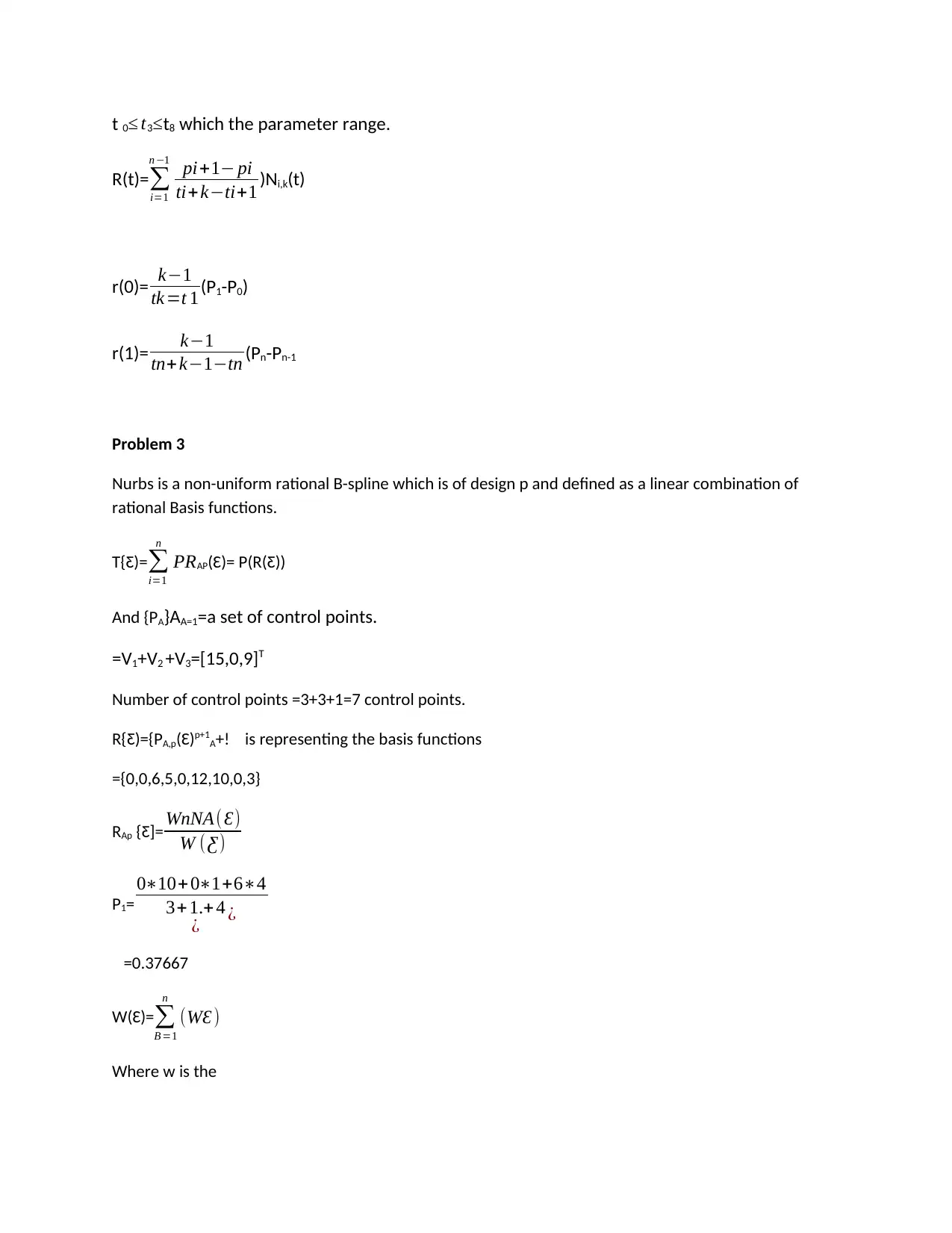
t 0≤ t3≤t8 which the parameter range.
R(t)=∑
i=1
n −1 pi+1− pi
ti+k−ti+1 )Ni,k(t)
r(0)= k−1
tk=t 1(P1-P0)
r(1)= k−1
tn+k−1−tn (Pn-Pn-1
Problem 3
Nurbs is a non-uniform rational B-spline which is of design p and defined as a linear combination of
rational Basis functions.
T{Ƹ)=∑
i=1
n
PRAP(Ɛ)= P(R(Ƹ))
And {PA}AA=1=a set of control points.
=V1+V2 +V3=[15,0,9]T
Number of control points =3+3+1=7 control points.
R{Ƹ)={PA,p(Ɛ)p+1A+! is representing the basis functions
={0,0,6,5,0,12,10,0,3}
RAp {Ƹ]= WnNA(Ɛ)
W ( Ƹ)
P1=
0∗10+0∗1+6∗4
3+ 1.+ 4
¿ ¿
=0.37667
W(Ɛ)=∑
B =1
n
(WƐ )
Where w is the
R(t)=∑
i=1
n −1 pi+1− pi
ti+k−ti+1 )Ni,k(t)
r(0)= k−1
tk=t 1(P1-P0)
r(1)= k−1
tn+k−1−tn (Pn-Pn-1
Problem 3
Nurbs is a non-uniform rational B-spline which is of design p and defined as a linear combination of
rational Basis functions.
T{Ƹ)=∑
i=1
n
PRAP(Ɛ)= P(R(Ƹ))
And {PA}AA=1=a set of control points.
=V1+V2 +V3=[15,0,9]T
Number of control points =3+3+1=7 control points.
R{Ƹ)={PA,p(Ɛ)p+1A+! is representing the basis functions
={0,0,6,5,0,12,10,0,3}
RAp {Ƹ]= WnNA(Ɛ)
W ( Ƹ)
P1=
0∗10+0∗1+6∗4
3+ 1.+ 4
¿ ¿
=0.37667
W(Ɛ)=∑
B =1
n
(WƐ )
Where w is the

Is the corresponding weights of the basis function. R3
T{Ɛ)=Type equation here .
T{Ɛ)=Type equation here .
1 out of 7
Related Documents
Your All-in-One AI-Powered Toolkit for Academic Success.
+13062052269
info@desklib.com
Available 24*7 on WhatsApp / Email
![[object Object]](/_next/static/media/star-bottom.7253800d.svg)
Unlock your academic potential
© 2024 | Zucol Services PVT LTD | All rights reserved.



